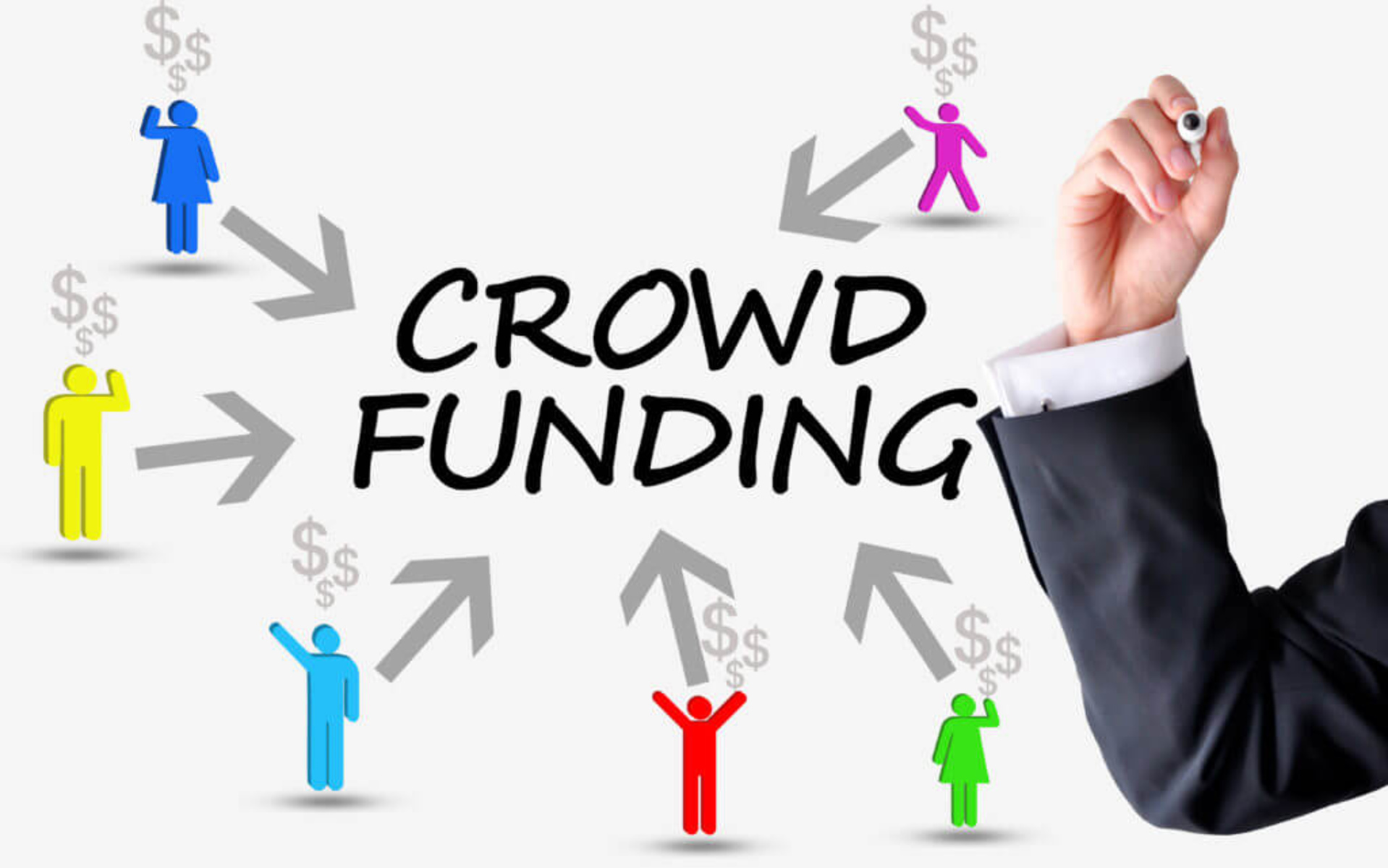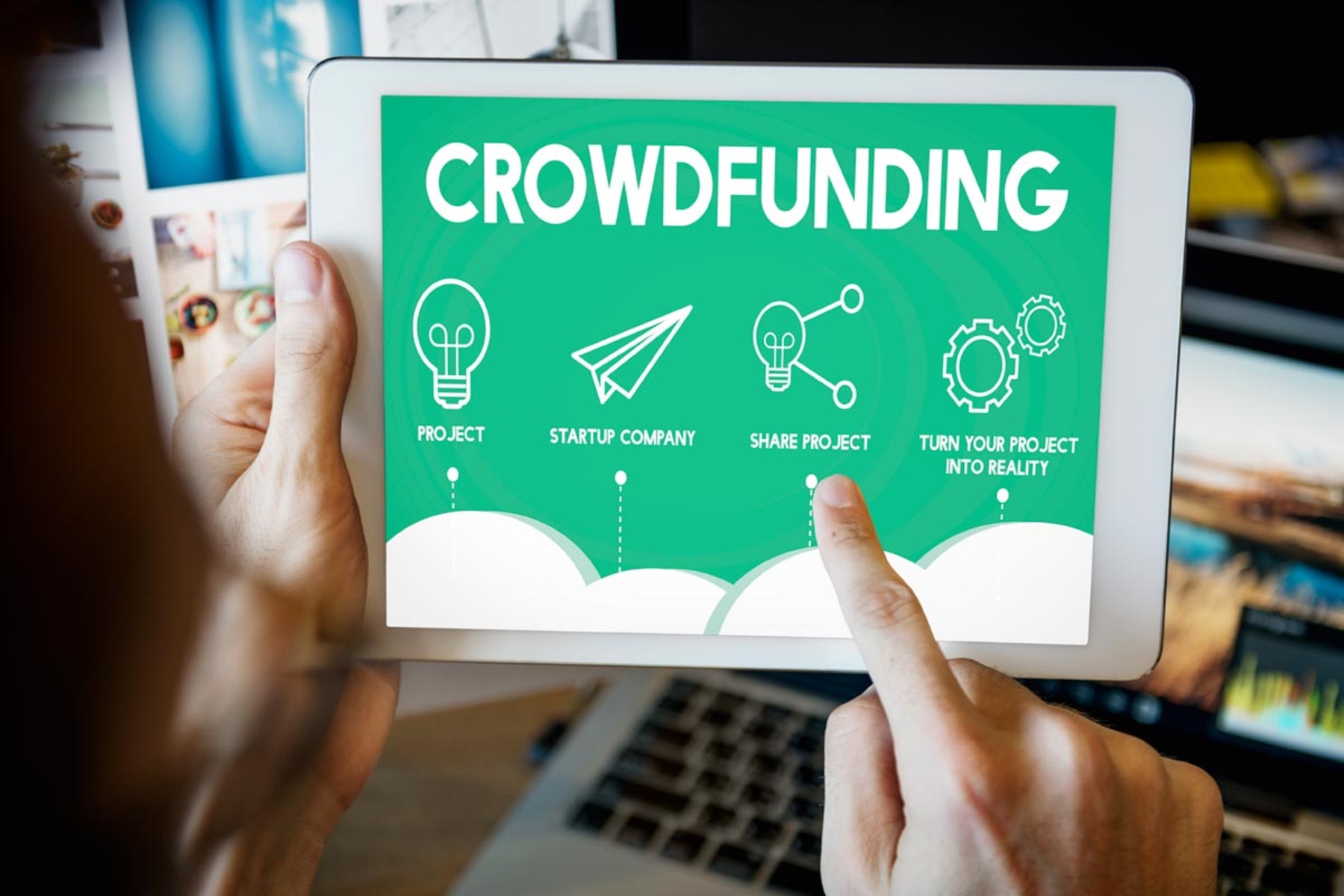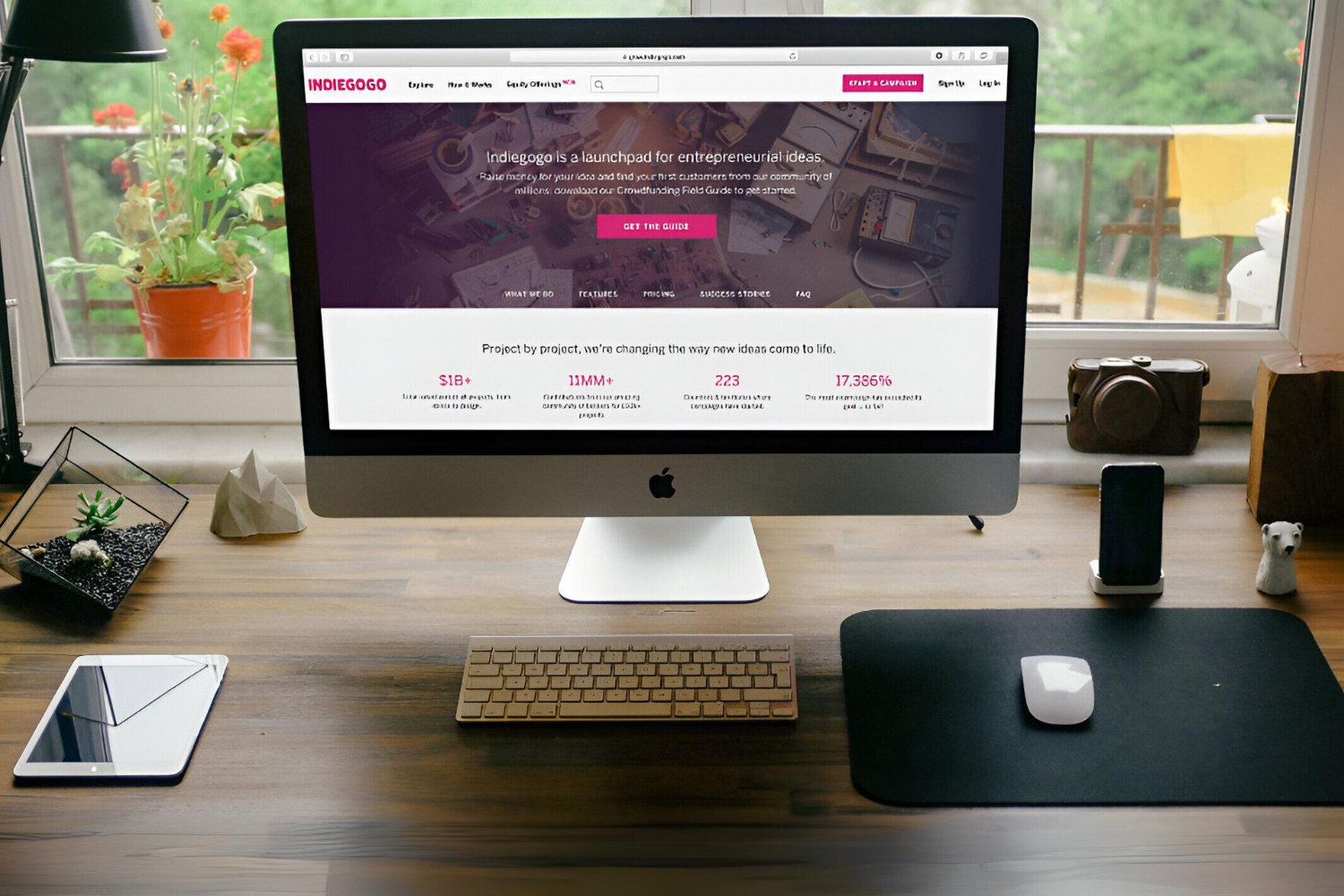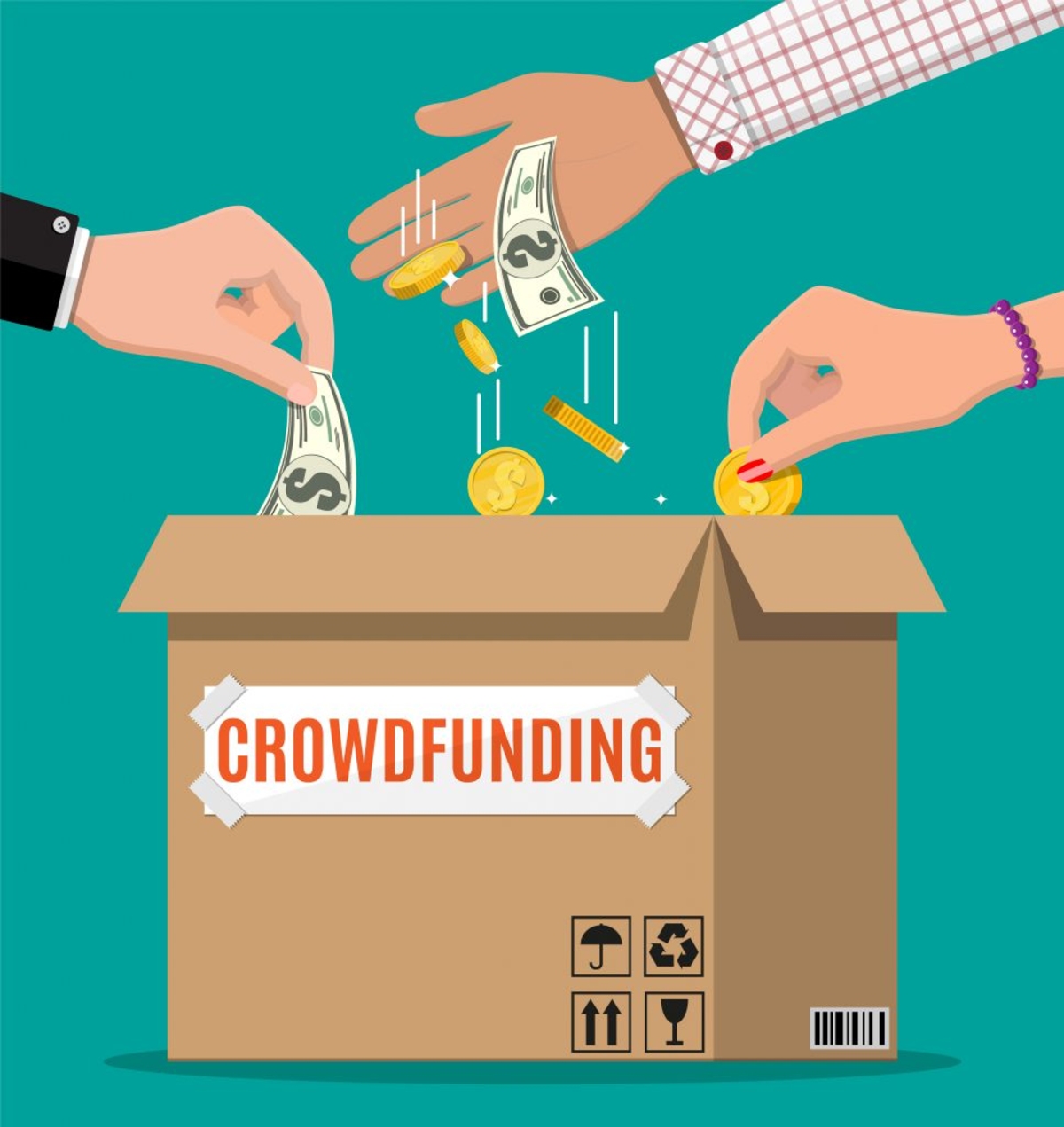Introduction
Crowdfunding has revolutionized the way individuals and businesses raise funds for various projects and initiatives. With the power of the internet and the collective support of a diverse group of backers, crowdfunding has become a popular alternative to traditional funding methods.
But what exactly is crowdfunding? In simple terms, crowdfunding is the practice of raising money from a large number of people, typically through an online platform, to fund a project or venture. It allows individuals, entrepreneurs, artists, and non-profit organizations to tap into the collective resources of a community of supporters.
What sets crowdfunding apart from traditional fundraising methods is the democratization of the process. Instead of relying on a few wealthy investors or financial institutions, crowdfunding allows anyone with an internet connection and a compelling idea to seek funding from a wide range of backers, from family and friends to complete strangers.
One of the key benefits of crowdfunding is that it enables creators and innovators to showcase their projects to a global audience and receive direct support from those who believe in their vision. It provides a platform for individuals and organizations to validate their ideas, gather feedback, and build a community around their work.
Moreover, crowdfunding offers backers the opportunity to be more than just passive investors. They become active participants in the success of the project, gaining a sense of ownership and connection to the cause they support. In return for their financial contribution, backers may receive rewards, equity in the venture, or simply the satisfaction of knowing that they played a part in bringing an idea to life.
As the popularity of crowdfunding continues to grow, different types of crowdfunding models have emerged to cater to the diverse needs of creators and backers. In the following sections, we will explore some of the main types of crowdfunding and provide examples of popular crowdfunding platforms.
What is crowdfunding?
Crowdfunding, at its core, is a funding method that harnesses the collective power of a large number of people to finance a project or venture. It involves raising small amounts of money from a large group of individuals, typically through an online platform.
One of the defining characteristics of crowdfunding is the direct connection it creates between creators and their audience. Instead of relying on traditional financial institutions, crowdfunding allows creators to directly solicit funds from their supporters, eliminating the need for intermediaries.
The concept of crowdfunding is not a new phenomenon. In fact, it has roots in the age-old practice of communal funding, where communities would come together to pool their resources and fund projects for the common good. What sets modern crowdfunding apart is the internet’s ability to connect people across vast distances and the exponential reach it provides.
Creators and entrepreneurs can now present their ideas and projects to a global audience, gaining exposure and attracting potential backers from all corners of the world. This global reach has democratized the funding process, allowing anyone with a compelling idea to seek support from individuals who resonate with their vision.
There are several key benefits to crowdfunding. First and foremost, it offers a viable alternative to traditional financing options, which can be challenging to access for many creators and entrepreneurs, especially those without a proven track record or collateral to offer. Crowdfunding provides a platform for individuals and organizations to fundraise based on the merit of their ideas and the trust they build with their backers.
In addition, crowdfunding allows creators to test the market demand for their products or services before investing significant time and resources. By presenting their projects to a wide audience, they can gather feedback and refine their offerings based on the response they receive, minimizing the risks associated with launching a new venture.
Moreover, crowdfunding fosters a sense of community and engagement among creators and their backers. It creates a network of individuals who are not just financial supporters but also advocates for the project’s success. Backers often become brand ambassadors, spreading the word about the initiative and attracting more supporters to join the cause.
Overall, crowdfunding has become a powerful tool for individuals and organizations to overcome funding barriers and bring their ideas to life. With its ability to connect creators and backers from around the world, crowdfunding has democratized the funding landscape, enabling a diverse range of projects to find support and thrive.
Different types of crowdfunding
Crowdfunding has evolved to cater to the unique needs of various creators and projects. As a result, different types of crowdfunding models have emerged, each with its own characteristics and fundraising approach. Here are some of the main types of crowdfunding:
Rewards-based crowdfunding:
Rewards-based crowdfunding is one of the most common forms of crowdfunding. In this model, creators offer a range of rewards or perks to backers who contribute to their campaign. These rewards can vary widely, from early access to the product or service being funded, exclusive merchandise, personalized experiences, or credits in the final production. Backers are motivated to support the project not only by the desire to see it succeed but also by the incentives offered.
Equity crowdfunding:
Equity crowdfunding allows backers to become investors in a project or business. In this model, individuals receive shares or equity in the venture in exchange for their financial contribution. This type of crowdfunding is particularly popular among startups and small businesses seeking investment capital. By offering equity, creators can raise larger sums of money and, at the same time, build a community of shareholders who have a vested interest in the success of the venture.
Donation-based crowdfunding:
Donation-based crowdfunding relies on the generosity of individuals who are willing to contribute to a cause or project without expecting any financial return. This type of crowdfunding is commonly used for charitable initiatives, medical expenses, educational campaigns, or community-driven projects. Donors are driven by their desire to support a meaningful cause and make a positive impact on society.
Debt crowdfunding:
Debt crowdfunding, also known as peer-to-peer lending, involves individuals lending money to others in need. In this model, backers provide loans to creators or businesses, and they are repaid with interest over a specified period. Debt-based crowdfunding provides an avenue for borrowers who may not be eligible for traditional loans to secure funding from a community of lenders.
These are just a few examples of the types of crowdfunding available today. Each model offers its own set of advantages and considerations, and creators should choose the one that aligns best with their specific needs and goals.
Understanding the different types of crowdfunding can help creators select the most appropriate platform and approach to fund their projects successfully. By leveraging the power of the crowd, individuals and organizations can turn their ideas into reality and gain the support they need to bring their visions to life.
Rewards-based crowdfunding
Rewards-based crowdfunding is a popular type of crowdfunding that allows creators to offer various rewards or perks to backers who contribute to their campaign. This model provides a win-win situation for both the creators and the supporters, as it allows creators to raise funds for their projects while offering something valuable in return to their backers.
One of the key advantages of rewards-based crowdfunding is the ability to tap into a motivated community of backers who are not only interested in supporting a project but also eager to receive unique incentives. These rewards can take many forms, depending on the nature of the project and the creativity of the creators.
For instance, in a film or music crowdfunding campaign, creators may offer exclusive access to behind-the-scenes content, signed merchandise, tickets to premieres or shows, or even the opportunity to meet the artists. These rewards create a sense of exclusivity and allow backers to feel more connected to the project they are supporting.
In the realm of product development, rewards-based crowdfunding enables creators to offer early access to their products or discounted prices during the campaign. Backers who are early adopters can be rewarded with limited edition versions of the product, customization options, or additional accessories that are exclusive to the crowdfunding campaign.
Creators can also get creative with their rewards by offering personalized experiences, such as one-on-one consultations, workshops, or unique opportunities to collaborate with the project’s team. These rewards not only incentivize backers to contribute at higher levels but also foster a sense of community and involvement.
Additionally, rewards-based crowdfunding serves as a marketing and validation tool for creators. By presenting their project to a community of backers and offering enticing rewards, creators can gauge the level of interest and demand for their product or service. This feedback can be valuable in refining their offerings before launching to a wider market.
Popular platforms like Kickstarter and Indiegogo have gained significant traction in the rewards-based crowdfunding space. These platforms provide a user-friendly interface for creators to showcase their projects, set funding goals, and offer rewards to their backers.
Ultimately, rewards-based crowdfunding offers a unique opportunity for creators to engage with their community, raise funds, and validate their ideas. The exchange of rewards creates a sense of value and appreciation for backers, ensuring their continued support and fostering a loyal fan base for the project.
Whether it’s supporting a film production, a musical endeavor, or the development of a new product, rewards-based crowdfunding has become a popular model that empowers creators to turn their vision into reality.
Equity crowdfunding
Equity crowdfunding is a unique form of crowdfunding where backers become investors in a project or business by acquiring shares or equity in the venture. Unlike rewards-based crowdfunding, where backers receive non-financial perks, equity crowdfunding offers a financial stake in the success of the project.
One of the key advantages of equity crowdfunding is that it provides an opportunity for creators to raise larger sums of money compared to other crowdfunding models. By offering equity, creators can attract investors who are interested in the long-term potential returns of the venture. This type of crowdfunding is particularly popular among startups and small businesses looking for investment capital to fuel their growth and development.
Equity crowdfunding not only provides creators with access to funding but also allows them to build a community of shareholders who are aligned with their vision and invested in the venture’s success. Backers who become shareholders have a stake in the company’s future, incentivizing them to actively support and promote the project.
For investors, equity crowdfunding opens up exciting opportunities to invest in early-stage businesses and innovative ideas that may have the potential for significant growth and returns. It allows individuals to diversify their investment portfolios and support projects they believe in, even if they don’t have access to traditional investment avenues.
Equity crowdfunding also offers benefits for backers beyond their potential financial returns. Investors can often gain insight into the inner workings of the company, attend annual meetings, and have a voice in decision-making processes, depending on the level of equity they hold. This level of engagement allows backers to feel connected and involved in the journey of the project, beyond just providing financial support.
Platforms like SeedInvest and StartEngine have emerged as popular equity crowdfunding platforms, providing creators with a platform to pitch their businesses and attract potential investors. These platforms often have strict regulations and vetting processes in place to ensure the credibility and transparency of the projects being listed.
Equity crowdfunding is an innovative way to fund businesses and startups, providing creators with much-needed capital and backers with investment opportunities. It fosters a sense of community, collaboration, and shared success, as creators and backers work together to bring promising ideas to fruition and unlock their growth potential.
While equity crowdfunding comes with its own set of risks and considerations, it has become an increasingly viable option for creators and investors looking to participate in the exciting world of entrepreneurship and innovation.
Donation-based crowdfunding
Donation-based crowdfunding is a type of crowdfunding that relies on the generosity of individuals who are willing to contribute to a cause or project without expecting any financial return. This model is commonly used for charitable initiatives, medical expenses, educational campaigns, or community-driven projects.
The primary motivation for backers in donation-based crowdfunding is the desire to support a meaningful cause and make a positive impact on society. Backers are driven by empathy, compassion, and a genuine belief in the mission and purpose of the project they are supporting.
One of the key advantages of donation-based crowdfunding is its ability to bring together a community of like-minded individuals who share a common vision. This community, motivated by a shared cause, forms a strong support network for the project and helps amplify its reach and impact.
Donation-based crowdfunding campaigns often leverage the power of storytelling to connect with potential backers on an emotional level. By sharing compelling narratives, personal experiences, and the impact their project can make, creators can elicit empathy and inspire individuals to contribute.
Platforms like GoFundMe and JustGiving have become popular choices for donation-based crowdfunding, providing a user-friendly interface for creators to share their stories, set fundraising goals, and track their progress. These platforms also offer social sharing tools to enable backers to spread the word and rally support from their network.
Donation-based crowdfunding can benefit various causes and initiatives. It offers a lifeline for individuals in need, providing financial support for medical treatments, emergency situations, or personal hardships. It can also empower grassroots organizations and non-profit initiatives by giving them a platform to raise funds for their projects and expand their reach.
Furthermore, donation-based crowdfunding allows individuals to engage and participate in positive change, even if they are unable to contribute significant amounts of money. It democratizes the act of giving and makes philanthropy accessible to a wide range of people.
While there may not be direct financial returns for backers in donation-based crowdfunding, the emotional reward of knowing they have made a difference can be incredibly fulfilling. Backers become part of a larger movement, knowing that their contributions have helped bring about meaningful change in someone’s life or supported a cause they deeply care about.
Donation-based crowdfunding exemplifies the power of collective generosity and the ability of individuals to come together to make a positive impact in the world. It serves as a testament to the kindness and compassion of humanity and highlights the potential for positive change through collective action.
Debt crowdfunding
Debt crowdfunding, also known as peer-to-peer lending, is a type of crowdfunding where individuals lend money to others in need. In this model, backers provide loans to creators or businesses, and they are repaid with interest over a specified period.
One of the key advantages of debt crowdfunding is that it provides an alternative source of funding for borrowers who may not be eligible for traditional loans from banks or financial institutions. By tapping into a community of lenders, individuals and businesses can secure the capital they need to pursue their projects or ventures.
In debt crowdfunding campaigns, creators outline the purpose of the loan, the repayment terms, and the interest rate offered to backers. This transparent approach allows lenders to evaluate the risk and potential return on their investment before deciding to contribute.
Lenders in debt crowdfunding can diversify their investment portfolios by participating in various loan opportunities. They can choose to lend to projects they believe in, take advantage of promising interest rates, and potentially earn passive income from the interest accrued on their loans.
Debt crowdfunding platforms like LendingClub and Funding Circle have gained popularity as intermediaries between borrowers and lenders. These platforms facilitate the loan process, providing the necessary infrastructure, credit checks, and legal documentation to ensure a smooth and secure lending experience.
Debt crowdfunding also encourages a sense of financial empowerment as it allows individuals to participate in the lending process directly. It provides an avenue for lenders to support projects and individuals they believe in, rather than relying on traditional banking systems.
Moreover, debt crowdfunding enables creators to maintain control over their projects while accessing the necessary funding. Unlike in equity crowdfunding, where backers become shareholders and have a say in decision-making processes, debt crowdfunding allows creators to retain full ownership and control over their ventures.
This type of crowdfunding is particularly useful for creators who have a clear plan for repayment and need a financial boost to propel their projects forward. It can support various endeavors, from small business expansions and product development to personal endeavors such as education or healthcare expenses.
By providing an alternative to traditional banking systems, debt crowdfunding promotes financial inclusivity and empowers both borrowers and lenders. It offers an opportunity for individuals to participate in the lending market, support projects they believe in, and potentially earn returns on their investments.
While there are risks associated with debt crowdfunding, including default or delay in repayment, the transparent nature of the lending process and the ability for lenders to diversify their investments helps mitigate some of these risks. Overall, debt crowdfunding offers a mutually beneficial platform for borrowers and lenders to connect and support each other’s financial goals.
Examples of crowdfunding platforms
Crowdfunding platforms have played a vital role in the growth and popularity of crowdfunding. These platforms provide creators with the tools and resources they need to showcase their projects, connect with backers, and raise funds. Here are a few examples of popular crowdfunding platforms:
Kickstarter:
Kickstarter is one of the most well-known and widely used crowdfunding platforms. It enables creators from various fields, including arts, technology, design, and more, to present their projects to a global audience. Kickstarter operates on a rewards-based crowdfunding model, where creators offer unique incentives to backers who contribute to their campaigns. Projects funded on Kickstarter range from innovative gadgets and creative works to community initiatives and social causes.
Indiegogo:
Indiegogo is another prominent crowdfunding platform that offers a range of fundraising options for creators. It supports both rewards-based and equity-based crowdfunding campaigns. Indiegogo has a strong focus on entrepreneurial ventures, with a wide range of categories such as tech, film, fashion, and more. It provides creators with the flexibility to choose between fixed funding, where projects must reach their funding goals to receive the funds, and flexible funding, where creators keep the funds raised even if the target is not reached.
GoFundMe:
GoFundMe is a popular platform for donation-based crowdfunding. It allows individuals to raise funds for personal causes, medical expenses, education, and charitable initiatives. GoFundMe has a user-friendly interface that simplifies the process of creating and sharing campaigns. Backers can easily contribute to causes they care about and share campaigns on social media to amplify their impact. GoFundMe has gained widespread recognition and has helped individuals and communities in times of need.
SeedInvest:
SeedInvest stands out as one of the leading platforms for equity crowdfunding. It focuses on supporting early-stage startups and aims to bridge the gap between investors seeking investment opportunities and entrepreneurs in need of capital. SeedInvest provides a rigorous vetting process to ensure that only high-quality, innovative startups are listed on their platform. This increases investor confidence and offers a platform for startups to gain exposure to accredited investors who believe in their potential.
These are just a few examples of the many crowdfunding platforms available today. Each platform offers unique features, caters to different types of projects, and operates on various crowdfunding models. Choosing the right platform depends on the type of project, funding goals, and the desired level of engagement with backers and investors.
Regardless of the platform chosen, crowdfunding has opened up new opportunities for creators from all walks of life to access funding, establish a community of supporters, and turn their ideas into reality.
Kickstarter
Kickstarter is one of the most popular and influential crowdfunding platforms in the world. Founded in 2009, Kickstarter has helped thousands of creators bring their innovative ideas to life by providing them with a platform to raise funds from a global community of backers.
One of the key features of Kickstarter is its rewards-based crowdfunding model. Creators offer a range of rewards to backers who contribute to their campaigns, creating a sense of exclusivity and appreciation for their support. These rewards can vary from early access to the product being funded, limited edition merchandise, personalized experiences, or credits in the final production.
With a wide range of categories, such as technology, arts, design, film, and more, Kickstarter caters to a diverse community of creators and backers. It allows creators to showcase their projects through multimedia content, including videos, images, and detailed descriptions, enabling them to clearly communicate their vision and connect with potential supporters.
One of the benefits of Kickstarter is its all-or-nothing funding approach. Creators set a funding target, and if the campaign does not reach this goal by the set deadline, no funds are exchanged, and the project does not proceed. This approach adds a sense of urgency and encourages backers to rally behind the project to ensure its success.
Kickstarter has proven to be a launchpad for many successful products and ventures. Notable projects that originated on Kickstarter include the Pebble smartwatch, the Oculus Rift virtual reality headset, and the Exploding Kittens card game. These success stories have not only attracted media attention but have also demonstrated the power of crowdfunding in bringing innovative ideas to mainstream markets.
Through its extensive network of creators and backers, Kickstarter has fostered a vibrant and engaged community. Backers often provide valuable feedback and engage in discussions with creators, forming a sense of shared ownership and connection to the projects they support.
In recent years, Kickstarter has also expanded its reach beyond the traditional crowdfunding model. It introduced Kickstarter Live, a feature that allows creators to host live video sessions to engage with their backers directly. This feature creates an interactive and personal experience, fostering a deeper connection between creators and their community.
Overall, Kickstarter continues to play a significant role in revolutionizing the way projects are funded and bringing creative ideas to life. The platform has democratized the access to funding, empowering creators to turn their dreams into reality, while also providing backers with the opportunity to support innovative projects and become a part of the journey.
Indiegogo
Indiegogo is a prominent crowdfunding platform that offers a range of fundraising options for creators across different industries. Since its launch in 2008, Indiegogo has enabled thousands of creators to bring their ideas to life by providing them with a platform to raise funds from a global network of backers.
One of the distinguishing features of Indiegogo is its flexible funding model. Creators can choose between fixed funding or flexible funding campaigns. Fixed funding campaigns require the project to reach its funding goal within a set timeframe; otherwise, all the funds are returned to the backers. Flexible funding campaigns allow creators to keep the funds raised, regardless of whether the funding goal is met or not. This flexibility provides added options for creators and enables them to proceed with their projects even if they haven’t reached their initial fundraising target.
Indiegogo caters to a wide range of creative projects, including technology, film, fashion, art, and more. The platform allows creators to showcase their projects through multimedia content, including videos, images, and detailed descriptions. This helps to effectively communicate their ideas and engage potential backers.
In addition to its rewards-based crowdfunding model, Indiegogo has also introduced equity crowdfunding on its platform. This allows startups and emerging businesses to offer equity or debt-based investment opportunities to accredited investors. This expansion into equity crowdfunding has broadened Indiegogo’s scope, providing creators with alternative ways to raise capital and investors with new opportunities to support innovative ventures.
Indiegogo also emphasizes the importance of community and collaboration. The platform provides tools for creators to engage with their backers, participate in discussions, and update their community on project progress. This interaction fosters a sense of involvement and shared ownership among backers, further strengthening the bond between creators and their supporters.
Indiegogo has played a significant role in enabling the success of numerous projects and campaigns. Notable projects that have found success on Indiegogo include the Jibo social robot, the Sondors eBike, and the Flow Hive beehive. These projects have not only received substantial financial support but have also gained widespread recognition and media attention, propelling them to achieve even greater success.
Overall, Indiegogo continues to be a transformative platform that empowers creators to bring their ideas to life. Its flexibility, diverse project categories, and emphasis on community engagement have made it a go-to platform for crowdfunding campaigns. Whether it’s funding the next breakthrough technology or supporting creative artistic endeavors, Indiegogo provides a platform where creators and backers can come together to make remarkable ideas a reality.
GoFundMe
GoFundMe is a leading crowdfunding platform that focuses primarily on donation-based crowdfunding. Since its launch in 2010, GoFundMe has gained immense popularity and has helped individuals, families, and communities raise funds for various personal and charitable causes.
Unlike other crowdfunding platforms that cater to specific industries or project categories, GoFundMe is widely used for a wide range of purposes. It allows individuals to create campaigns to raise funds for medical expenses, education, disaster relief, community projects, and more.
One of the key strengths of GoFundMe is its user-friendly interface, which simplifies the campaign creation process. Creators can easily set up their campaigns, tell their stories through text, images, and videos, and customize their campaign pages to reflect their cause and objectives.
GoFundMe’s success can be attributed to its ability to harness the power of social sharing. The platform provides easy-to-use sharing tools that allow creators and backers to spread the word about their campaigns on social media platforms. This, in turn, amplifies the reach of the campaign and helps garner support from a wider audience.
Another noteworthy feature of GoFundMe is its emphasis on community engagement and support. Creators can interact with their backers through thank-you messages, updates, and comments, fostering a sense of connection and appreciation. Backers also have the opportunity to leave messages of encouragement and support, creating a supportive network around the campaign.
GoFundMe has been instrumental in helping individuals and communities during times of crisis. It has served as a platform for fundraising in emergency situations, natural disasters, and medical emergencies. The ease of use and wide reach of GoFundMe have facilitated swift and significant assistance, making a tangible impact on the lives of those in need.
Supporting charitable causes is another key aspect of GoFundMe. Many non-profit organizations and community-driven initiatives have utilized the platform to raise funds for their projects and campaigns. Backers are drawn to the transparency and direct impact they can have by contributing to causes they care about.
Over the years, GoFundMe has become synonymous with compassion and generosity. From helping individuals overcome financial hardships to supporting large-scale humanitarian efforts, GoFundMe has enabled countless acts of kindness and has proven to be a powerful tool for mobilizing support and making a positive difference.
Whether it’s providing relief in times of crisis or supporting personal aspirations, GoFundMe continues to connect people in need with those who are willing to help. It has become a crowdfunding platform that embodies the spirit of giving, compassion, and community support.
SeedInvest
SeedInvest is a leading equity crowdfunding platform that focuses on connecting early-stage startups with accredited investors. Founded in 2012, SeedInvest has played a significant role in democratizing the investment landscape by providing a platform that allows startups to raise capital and investors to support promising ventures.
One of the noteworthy features of SeedInvest is its rigorous selection process for startups. The platform carefully vets potential companies, ensuring that only high-quality, innovative startups with viable business models are listed on the platform. This level of curation provides investors with a sense of confidence and helps mitigate some of the risks associated with early-stage investing.
Through SeedInvest, startups have the opportunity to offer equity or debt-based investment opportunities to accredited investors, who can participate with varying investment amounts. This allows startups to secure the funding they need to fuel growth and development, while investors gain access to exciting investment opportunities that they may not have otherwise had access to.
SeedInvest offers an interactive and user-friendly experience. The platform provides detailed information about each listed startup, including their business model, financials, and team backgrounds. Potential investors can review these details and make informed investment decisions based on the information provided.
Another key advantage of SeedInvest is its focus on investor communication and engagement. Once an investment is made, investors receive regular updates and progress reports from the startups they have supported. This transparency and ongoing communication create a sense of involvement and enable investors to stay informed about the progress and milestones achieved by the companies they have invested in.
SeedInvest also operates as a registered broker-dealer, ensuring that it complies with regulatory requirements associated with equity crowdfunding. This adds an extra layer of security and trust for both startups and investors, as the platform adheres to the necessary legal and financial regulations.
Since its founding, SeedInvest has facilitated the successful funding of numerous startups across various industries, including technology, healthcare, consumer goods, and more. Notable success stories from the platform include companies like Eaze, Knightscope, and PillPack, which have gone on to achieve significant growth and success.
SeedInvest has been at the forefront of revolutionizing the investment landscape by leveraging the power of crowdfunding. By providing a platform that connects startups and investors, SeedInvest has created opportunities for emerging companies to secure funding and for investors to participate in the growth of innovative ventures.
Overall, SeedInvest has established itself as a leading equity crowdfunding platform, offering an avenue for accredited investors to support promising startups and for entrepreneurs to gain access to much-needed capital. It has opened doors for innovation and collaboration, fueling the development of groundbreaking companies and creating opportunities for investors to be a part of their success stories.
Conclusion
Crowdfunding has transformed the way ideas are funded and has opened doors for creators and entrepreneurs around the world. Through the power of the internet and the collective support of a diverse community of backers, crowdfunding has become a viable alternative to traditional funding methods.
The different types of crowdfunding, including rewards-based, equity-based, donation-based, and debt-based, have provided creators with flexibility and options to raise funds that align with their specific needs and goals. Whether it’s offering unique rewards to backers, selling equity or debt, or seeking support from generous donors, crowdfunding has democratized the fundraising process and made it accessible to a wider range of people.
Platforms like Kickstarter, Indiegogo, GoFundMe, and SeedInvest have emerged as leaders in the crowdfunding space, offering creators user-friendly interfaces, extensive networks of potential backers and investors, and resources to showcase their projects effectively. These platforms have facilitated the successful funding of numerous projects and have empowered creators to bring their visions to life.
Crowdfunding has not only provided financial support but has also fostered a sense of community and engagement. Backers become active participants in the success of the projects they support, forming a bond with creators and becoming advocates for their initiatives. This sense of ownership and involvement has created a new model of fundraising that emphasizes collaboration, feedback, and shared success.
Furthermore, crowdfunding has allowed creators to validate their ideas, gather feedback, and refine their offerings before launching to a broader market. It has provided a platform to test demand, identify target audiences, and build a loyal customer base even before a product or service is fully developed.
As crowdfunding continues to evolve, it redefines the funding landscape, giving individuals and organizations the opportunity to bring their creative ideas, entrepreneurial visions, and social causes to life. It breaks down barriers, opens doors of opportunity, and empowers creators and backers alike to make an impact and shape the future.
Crowdfunding has shown us the power of collective support, the strength of community, and the potential for change when individuals come together to support innovative and meaningful projects. With its innovative and inclusive approach to funding, crowdfunding has revolutionized the way we support and bring ideas to life in today’s interconnected world.

























